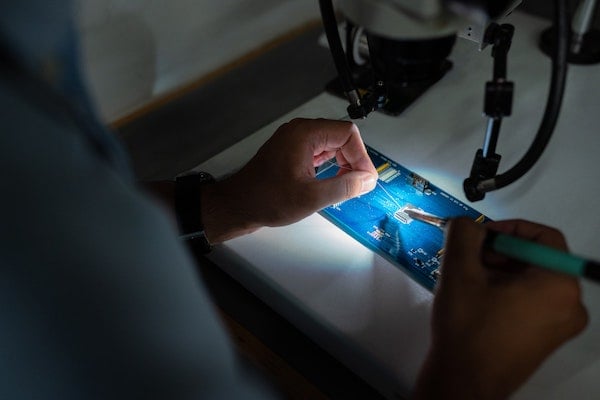Published on
Coping with an Existential Threat to Your Core Mission

Remote working and learning eliminate face-to-face interactions, which is a critical component in the community college world. As a result, students and even staff are beginning to look elsewhere for work and/or education. But this isn’t the first crisis higher education has faced, as it’s merely a transition to something new—just like when the world wide web initially hit campuses. Now, it’s up to faculty and their leaders to find creative solutions to retain their enrollment rates and deliver the best student (and employee) experience they can provide. In this interview, Kevin Drumm discusses the hard hit on enrollment rates, the nationwide response that’s needed, and what will happen to the hands-on experience.
The EvoLLLution (Evo): What impact has the shift had on folks in career and workforce programs that tend to be more hands-on and competency-based?
Kevin Drumm (KD): The competency-based course goes both ways, and a lot of that is didactic in nature. We had a lot of lab work online, which has its advantages and disadvantages. The advantage is that you can run a sequence over and over rather than doing it once in lab and learn from that one test. If you’re struggling in a particular area, you can repeat it if it’s been digitized.
On the other hand, you’re missing the hands-on experience, which we certainly want our health sciences and engineering students to have. Sound engineering is one of our popular STEM programs, and we can’t run that program without including a fair amount of hands-on work in order to evaluate equipment operation. As with health sciences, a lot of those labs are available online, but you can only go so far with them before needing to experience it in the lab or clinic. That’s where we are at this point with the many hands-on career activities that so many of us offer.
I spent a decade in the distance learning space before being able to do the things that digitization enables us to do today. Email, local access television and listservs were about the best we had. Then, the world wide web came around and transformed everything. But community colleges right now are particularly at risk. The situation we’re in is an existential threat to a major part of our core mission because so many students come to us in a socioeconomically vulnerable position to begin with, or now as a result of this pandemic. They need support services that are much more challenging to provide in this environment. A huge segment of the community college population is more precarious than ever, and they will probably drop out until they can get back on campus.
Evo: What impact does this shift have on your enrollment rates?
KD: We immediately noticed that between 500 and 600 of our students just weren’t engaging from a distance, and on March 20th, we did everything online. In that first week, we lost track of about 600 students. Now, not every student is cut out for distance learning, and community colleges are going to have more of those than any other sector just by the nature of our mission and the kind of student we attract. That’s definitely going to make community colleges struggle for the foreseeable future.
Our adult market for fall registration has seen an increase in enrollment, but that’s an anomaly when we compare ourselves to the community college demographic nationally for whatever reason. For years, about 30% of our sections have been online. We were in much better shape than many to get the rest online the coronavirus hit because we already had the infrastructure and training in place. But dealing with thousands of students was the much bigger challenge. When you have a full-time equivalent- (FTE) driven budget, it takes a lot of adult learners to make up for one full-time recent high school graduate. The numbers may wash out, as they often do in a recession, but the FTEs never will.
Evo: Are there any lessons that the community college sector can draw from the 2008 recession, or is it a fundamentally different situation?
KD: A lot of it is totally different, but I certainly do think there are some lessons to be applied–one being that we need more short-term opportunities for the adult working market to come out of this. Hopefully the economy will ramp back up faster than it did coming out of the 2008 recession, which lasted two or three years.
Those who are out of work right now are hoping to spend less than a year in college to upskil. Now, if they do it online, they can continue their education by taking fewer credits, as working adults typically do. That’s a good thing because we’ll be offering more online anyway.
Online was the only growing market of higher ed as the teenage market has tanked all across the country. We’ll see this become an emerging trend, which will accelerate more than it did in the past decade. How we maintain our campuses will likely change forever because it’s not the last time we’re going to get hit by a surprise virus. We’ll take any broader measures we can to help mitigate the next one.
Evo: What challenges are you anticipating as you try to move in this direction towards that highly responsive college?
KD: A major challenge will be whether or not we’ll be doing more with less. Where our fall enrollments are currently standing, it’s not looking good. As I said, there are some student who just aren’t suited to this learning environment.
As they enter the job market, students are looking for fields and disciplines that they want to go in rather than looking at what the job market will require in two or four years. A lot of our students considered the health sciences, and they have started to realize that it might be a more dangerous field than they initially thought. With 9/11, we saw people running to join the fire and police departments—right now, we’re seeing the opposite in health sciences as a result of this particular crisis. How long that will play out for remains to be seen.
That’s another potential long-term trend we need to look at because we already have a shortage of nurses. We can’t graduate nurses on time because they can’t finish their clinicals from their homes. This national shortage is going to be more acute because of all the associate degree programs. Bachelor’s degree programs are going to be able to graduate more students depending on when, in their four-year curriculum, they did their clinicals. They also might have been able to have their seniors do simulation labs rather putting them in the clinic, depending on how much clinic time they already had accumulated.
But for community colleges, it’s just not possible. There will thousands of potential new nurses with delayed graduation who will add to the nursing shortage as hospitals and clinics get back up to speed over the summer.
Evo: How will that impact the mission of the college?
KD: There’s no question the community college mission is at risk here more than any other sector’s. It’s going to hit across the board, particularly if you’re residential. At least two residential colleges that I’m aware of have already announced they’re going to be fully online in the fall. And their housing and food service operations will take huge hits as a result.
Our market can’t go fully online. We need to offer the hands-on experience at some point in the curriculum, both academically and on the support services side. We need that to maintain our mission and to survive financially. In the meantime, both are grave threats to the college and to higher education.
Evo: What do community colleges need to do nationwide to create the responsiveness necessary from this sector to prepare folks for a recession?
KD: We’ve done a fair amount of distance learning, but it still only made up about 30% of our offerings. Doing support outreach wasn’t overwhelming with the number and types of students who sign up for that mode. They tend to be a little more academically capable and a little more driven because they tend to be older and know what they want to do.
To be able to provide support services, we need to get better at offering academic student support services from a distance. Unless you’re a larger institution that has had a large distance learning operation running for some time, there’s always room to improve.
But you still need to expand and integrate it into college operations, which is going to take time. Most community college faculty and support professionals came into the field and stay in it because they love hands-on work with students. Zoom calls were not the reason they came into this field, and especially not to community colleges. This isn’t the best-suited situation to them, but they have to adapt to it—some better and faster than others. There may even be some who decide to change careers entirely because they realize the one they have is just not what they signed up for. The student market mirrors it: they didn’t sign up for the distance learning environment, and they really aren’t prepared for it.
Evo: Is there a fear that certain technologies will replace human work in the student support services?
KD: There are certainly technologies out there that are designed to replace some human work. It’s not the case for community college by any means. The work will be there for community college professional support staff, academic and student support staff. It will be different for a much bigger segment of our market, but it won’t eliminate any work at all, quite frankly. It’ll just be different work.
This interview was edited for length and clarity.
Editor’s note: This interview was recorded on April 24, 2020.



